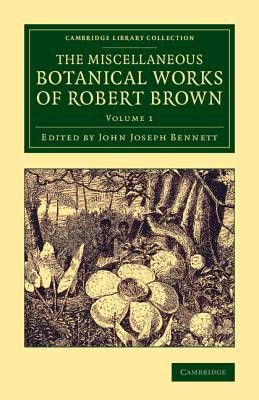
- We will send in 10–14 business days.
- Author: Robert Brown
- Publisher: Cambridge University Press
- ISBN-10: 1108076815
- ISBN-13: 9781108076814
- Format: 14 x 21.6 x 3.6 cm, minkšti viršeliai
- Language: English
- SAVE -10% with code: EXTRA
Reviews
Description
The botanist Robert Brown (1773-1858) is regarded as one of the most significant figures in the advancement of plant science in the nineteenth century. After studying at Aberdeen and Edinburgh, he made the acquaintance of Sir Joseph Banks via William Withering, and in 1801 was appointed as naturalist on Matthew Flinders' expedition to Australia. Brown made extensive collections of animals and minerals, but his 3,400 plant specimens from Australia, Tasmania and Timor were the foundation of his work for the rest of his life, as an active member of the Linnean Society, as Banks's librarian, and as an under-librarian in the British Museum. This two-volume collection of his 'miscellaneous botanical works', edited by John J. Bennett, Brown's assistant at the British Museum, was published in 1866-7. It has not been possible to reissue the accompanying quarto volume of plates. Volume 1 contains 'Geographico-Botanical Memoirs' and 'Structural and Physiological Memoirs'.
EXTRA 10 % discount with code: EXTRA
The promotion ends in 22d.14:05:52
The discount code is valid when purchasing from 10 €. Discounts do not stack.
- Author: Robert Brown
- Publisher: Cambridge University Press
- ISBN-10: 1108076815
- ISBN-13: 9781108076814
- Format: 14 x 21.6 x 3.6 cm, minkšti viršeliai
- Language: English English
The botanist Robert Brown (1773-1858) is regarded as one of the most significant figures in the advancement of plant science in the nineteenth century. After studying at Aberdeen and Edinburgh, he made the acquaintance of Sir Joseph Banks via William Withering, and in 1801 was appointed as naturalist on Matthew Flinders' expedition to Australia. Brown made extensive collections of animals and minerals, but his 3,400 plant specimens from Australia, Tasmania and Timor were the foundation of his work for the rest of his life, as an active member of the Linnean Society, as Banks's librarian, and as an under-librarian in the British Museum. This two-volume collection of his 'miscellaneous botanical works', edited by John J. Bennett, Brown's assistant at the British Museum, was published in 1866-7. It has not been possible to reissue the accompanying quarto volume of plates. Volume 1 contains 'Geographico-Botanical Memoirs' and 'Structural and Physiological Memoirs'.


Reviews